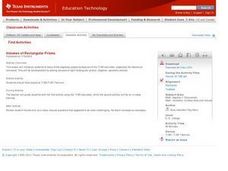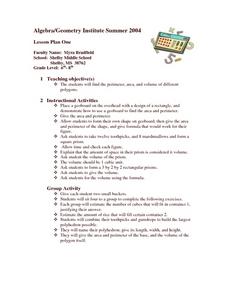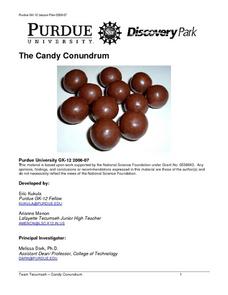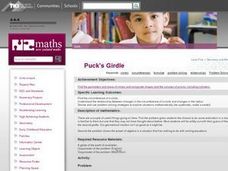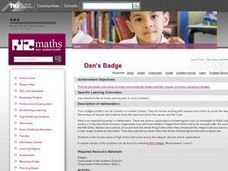Virginia Department of Education
Geometry and Volume
The history of math is fascinating! Utilize a woodcut primary source image from 1492 and posters from the 1930s to help geometers apply their volume-calculation skills to real-life questions.
EngageNY
Volume of Composite Three-Dimensional Objects
Most objects have irregular dimensions — you have to find them! Teach your class how to find the volume of composite objects that can be decomposed into prisms. Objects get increasingly more complex as the lesson progresses.
Curated OER
Shipping Rolled Oats
What better way to start your day than with a box of oatmeal? Or what better way to start your geometry class than by calculating its volume? Eighth graders discover just how practical volume computation can be in business and in breakfast!
Curated OER
Volumes of Rectangular Prisms
Students determine the volume of a rectangular prism. They then maximize and minimize the volume given variable side lengths. Finally, they factor the volume equation to determine the side lengths.
Utah Education Network (UEN)
Insides and Outsides
Give small groups handfuls of unit cubes and then dare them to build as many rectangular prisms as possible using only 12 cubes. This engaging activity serves as an introduction to the volume of solid figures. In addition to volume,...
Curated OER
Volume of Rectangular Prisms: Algebra/Geometry Institute Summer 2009
Learners find the volume of rectangular prisms. In this volume instructional activity, students use a formula to find the volume of rectangular prisms. They discuss the definition of volume and draw rectangular prisms. ...
Curated OER
Lesson One: Perimeter, Area, Volume
Students explore perimeter, area and volume. Using geoboards, toothpicks, and marshmallows, students create specific shapes. They are directed to use formulas to find the volume, area, and perimeter of the created shapes. In groups,...
Curated OER
The Candy Conundrum
Students design a candy container that contains a specific amount of candy. They demonstrate how an engineering problem can be solved with math and that there are multiple answers to the problem. They compute volume of spheres.
Curated OER
Measurement: 2D and 3D
Students solve volume problems. In this geometry lesson, the class watches a video about clean water (link provided) and individuals compare the volume of different prisms, including an actual drinking glass. Extension activities include...
Curated OER
Puck's Girdle
Fifth graders calculate the perimeters, areas, and volumes of everyday objects. They discuss the word problem involving Puck from the Shakespeare play "Mid-Summer Night's Dream," and invent and plan a method for solving the problem in...
American Statistical Association
Exploring Geometric Probabilities with Buffon’s Coin Problem
Scholars create and perform experiments attempting to answer Buffon's Coin problem. They discover the relationships between geometry and probability, empirical and theoretical probabilities, and area of a circle and square.
Curated OER
Dan's Badge
Students solve a math problem using area formulas of circles and squares. They read and discuss the problem, analyze images of badges, reconstruct the badge from the problem using circles and rulers, and share the solution with the class.
Curated OER
Peter's Second String
Fifth graders determine the maximum area and range of areas of a rectangle with a given perimeter. They discuss a word problem involving perimeter and area as a class, investigate the word problem using a piece of string, and in small...
Curated OER
Marshmallow Geometry
In this three-dimensional shapes geometry instructional activity, learners identify geometric solids and name their properties. They define "face," "edge," and "vertex," and construct geometric solids using marshmallows as vertices and...
TeachEngineering
Teach Engineering: Boxed in and Wrapped Up
Students find the volume and surface area of a rectangular box (e.g., a cereal box), and then figure out how to convert that box into a new, cubical box having the same volume as the original. As they construct the new, cube-shaped box...
Better Lesson
Better Lesson: Covering and Filling: Surface Area & Volume of Rectangular Prisms
Students apply their knowledge of surface area and volume to solve some problems for a box company. This lesson contains a detailed lesson plan, video explanations, rubrics, group work guidelines, slides containing problems, and...
Better Lesson
Better Lesson: Fractions and Volume
Creating a conceptual understanding of how to find the volume of rectangular prisms using fractional side lengths.
Better Lesson
Better Lesson: Prism or Pyramid?
Sixth graders explore the faces, bases, edges, and vertices of prisms and pyramids to help develop the concepts of volume and surface area.
Better Lesson
Better Lesson: Exploring Volume
Modeling volume with centimeter cubes deepens understanding of the formula for finding volume.
Other
West Contra Costa Usd: Volume: A Foundation in Unit Cubes [Pdf]
A very detailed instructional activity on determining the volume of rectangular prisms, teaching students how to derive the formula for volume, and to use it successfully. Plenty of examples, student work, and assessment options.



